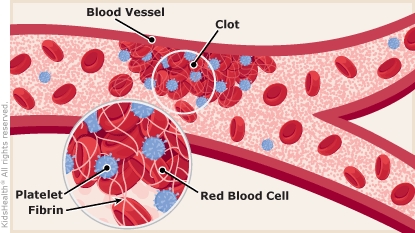Blood clots happen for many different reasons and usually are treated with medicines called anticoagulants. These are also called "blood thinners," even though they don't thin the blood. Instead, they prevent blood from clotting and stop blood clots from getting bigger. Your child's hematologist (blood specialist) will tell you if your child needs to stay on a blood thinner and for how long.

While your child is taking a blood thinner:
- Make sure your child takes all medicines on time and as directed.
- If your child misses a dose, call your hematologist right away.
- Don't give your child any medicines that the hematologist told you to avoid.
- Ask the hematologist before giving your child any new medicines (prescription or over-the-counter), vitamins, or herbal remedies.
- Do not give aspirin, ibuprofen (Advil®, Motrin®, or a store brand), or other non-steroidal anti-inflammatory medicines (NSAIDs) while your child takes the blood thinner.
- Follow the care team's instructions for your child's diet. They might ask you to avoid giving your child some foods or to keep the amounts of some foods about the same each day.
- Talk to your child's hematologist about any planned surgeries or procedures so you can plan to adjust or pause the blood thinner if needed.
- If your child gets a scratch or cut, check the skin carefully and watch for bleeding that doesn't stop. Apply pressure with clean gauze. If bleeding doesn't stop with pressure, take your child to the ER.
- Follow your hematologist's instructions about which activities your child should avoid while taking a blood thinner.
- Tell staff at your child's school or childcare about your child's condition and the possible side effects of the blood thinner.

Your child has:
- vomit with blood in it or that looks like coffee grounds
- bleeding you can't stop by applying pressure
- a fall or injury
Call 911 right away if your child has chest pain, is short of breath, has skin that looks blue, or seems confused.

What can cause blood clots? A blood clot can happen when a child has a central venous line or a peripherally inserted central catheter (PICC) line. Kids also can get blood clots if they're in the hospital lying still for a while.
Some medicines and health conditions also can cause blood clots. Problems with blood clots can be genetic and sometimes can run in families.




